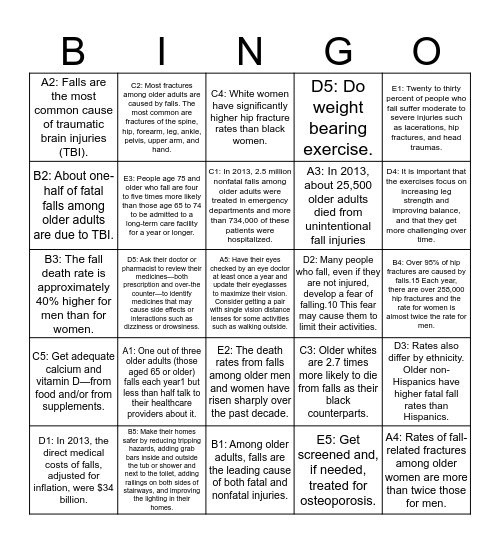

This bingo card has 25 words: A1: One out of three older adults (those aged 65 or older) falls each year1 but less than half talk to their healthcare providers about it., B1: Among older adults, falls are the leading cause of both fatal and nonfatal injuries., C1: In 2013, 2.5 million nonfatal falls among older adults were treated in emergency departments and more than 734,000 of these patients were hospitalized., D1: In 2013, the direct medical costs of falls, adjusted for inflation, were $34 billion., E1: Twenty to thirty percent of people who fall suffer moderate to severe injuries such as lacerations, hip fractures, and head traumas., A2: Falls are the most common cause of traumatic brain injuries (TBI)., B2: About one-half of fatal falls among older adults are due to TBI., C2: Most fractures among older adults are caused by falls. The most common are fractures of the spine, hip, forearm, leg, ankle, pelvis, upper arm, and hand., D2: Many people who fall, even if they are not injured, develop a fear of falling.10 This fear may cause them to limit their activities., E2: The death rates from falls among older men and women have risen sharply over the past decade., A3: In 2013, about 25,500 older adults died from unintentional fall injuries, B3: The fall death rate is approximately 40% higher for men than for women., C3: Older whites are 2.7 times more likely to die from falls as their black counterparts., D3: Rates also differ by ethnicity. Older non-Hispanics have higher fatal fall rates than Hispanics., E3: People age 75 and older who fall are four to five times more likely than those age 65 to 74 to be admitted to a long-term care facility for a year or longer., A4: Rates of fall-related fractures among older women are more than twice those for men., B4: Over 95% of hip fractures are caused by falls.15 Each year, there are over 258,000 hip fractures and the rate for women is almost twice the rate for men., C4: White women have significantly higher hip fracture rates than black women., D4: It is important that the exercises focus on increasing leg strength and improving balance, and that they get more challenging over time., D5: Ask their doctor or pharmacist to review their medicines—both prescription and over-the counter—to identify medicines that may cause side effects or interactions such as dizziness or drowsiness., A5: Have their eyes checked by an eye doctor at least once a year and update their eyeglasses to maximize their vision. Consider getting a pair with single vision distance lenses for some activities such as walking outside., B5: Make their homes safer by reducing tripping hazards, adding grab bars inside and outside the tub or shower and next to the toilet, adding railings on both sides of stairways, and improving the lighting in their homes., C5: Get adequate calcium and vitamin D—from food and/or from supplements., D5: Do weight bearing exercise. and E5: Get screened and, if needed, treated for osteoporosis..
Balance Bingo | Balance Bingo | Balance Bingo | Balance Bingo | Falls Bingo
Share this URL with your players:
For more control of your online game, create a clone of this card first.
Learn how to conduct a bingo game.
With players vying for a you'll have to call about __ items before someone wins. There's a __% chance that a lucky player would win after calling __ items.
Tip: If you want your game to last longer (on average), add more unique words/images to it.